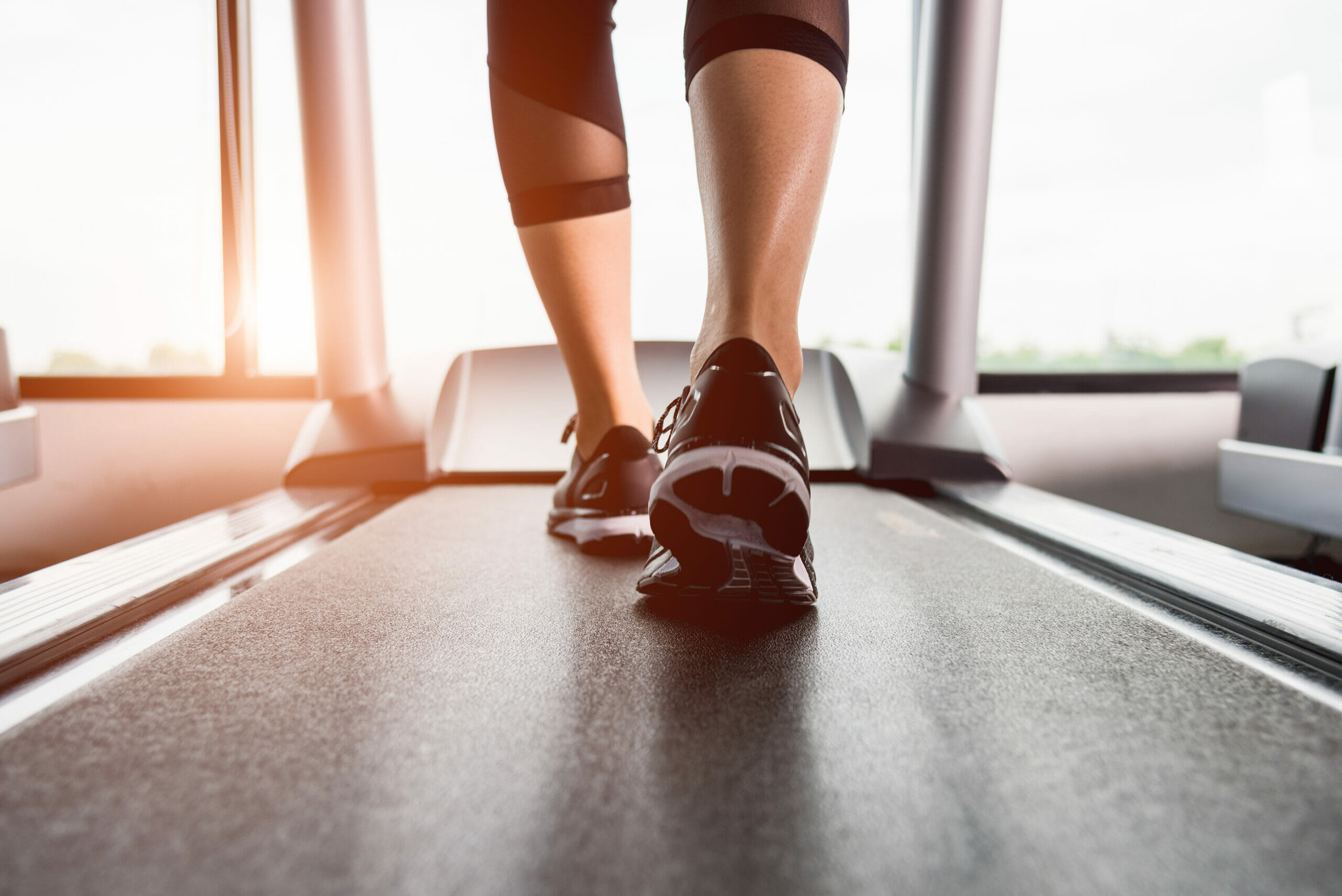
iFit has become one of the top fitness streaming platforms in the world and even though we might think of them as only being partnered with NordicTrack, there are actually several other brands that offer iFit compatibility too.
We’re talking household names like ProForm, as well as higher-end, less well-known brands like FreeMotion and Matrix.
This means we have plenty of options to choose from when looking for an iFit treadmill.
And even though it may be the iFit capabilities that you’re seeking, you still want to make sure you end up with a treadmill that’s built to last.
Well, that’s what I’m here to help with.
In this comprehensive guide, I’ll go over the best iFit compatible treadmills currently available, but I’ll also go over all the other specs you should consider before choosing a treadmill.
After reading, you’ll be more than ready to find the right iFit treadmill for your home gym.
Well, let’s get to it already.
| Running Surface | Motor | Frame | Warranty | |
|---|---|---|---|---|
| #1 Matrix T75 | 22" x 60" | 3.0 HP AC | 375 lb assembled weight 400 lb weight limit | Lifetime frame/motor 7 year parts 2 year labor |
| #2 NordicTrack Commercial 2450 | 20" x 60" | 3.6 CHP DC | ~260 lb assembled weight 300 lb weight limit | 10 year frame 2 year parts 1 year labor |
| #3 ProForm Pro 9000 | 20" x 60" | 3.6 CHP DC | ~220 lb assembled weight 300 lb weight limit | 10 year frame 2 year parts 1 year labor |
| #4 Matrix TF30 | 20" x 55" | 3.25 HP DC | 330 lb assembled weight 350 lb weight limit | Lifetime frame/motor 5 year parts 2 year labor |
| #5 NordicTrack Commercial 1250 | 20" x 60" | 3.0 CHP DC | ~240 lb assembled weight 300 lb weight limit | 10 year frame 2 year parts 1 year labor |
| #6 FreeMotion t8.9b | 21.5" x 60" | 4.0 HP AC | 359 lb assembled weight 400 lb weight limit | 7 year frame 3 year parts 3 year labor |
| #7 ProForm Pro 2000 | 20" x 60" | 3.25 CHP DC | ~220 lb assembled weight 300 lb weight limit | 10 year frame 2 year parts 1 year labor |
| #8 NordicTrack T 6.5 S | 20" x 55" | 2.6 CHP DC | ~200 lb assembled weight 300 lb weight limit | 10 year frame 2 year parts 1 year labor |
iFit Compatible Brands
If you’ve found your way to this article, I have to assume you already know what iFit is. Hell, even if you stumbled across this article accidentally, odds are you still know what iFit is.
I mean, it’s kinda hard to miss these days.
Yup, fitness streaming has really taken off and I really doubt it’s going anywhere anytime soon.
We have Peloton to thank for the whole streaming craze being what it is, but I would guess iFit has become more popular these days.
Don’t get me wrong, as a loyal Peloton owner for the last several years, I still think Peloton has one of the best platforms out there, but iFit is compatible across so many different machines and brands it’s gotta be hard for Peloton to keep up.
Oh, that reminds me, there are 2 ways a treadmill can be compatible with iFit – through the use of a built-in touchscreen console, or by connecting to your phone/tablet via bluetooth.
Technically speaking, you can follow an iFit workout on any treadmill by simply watching your tablet, but if you want to take advantage of the AutoAdjust technology, you need to go with one specifically designed to pair with iFit.
Opting for a treadmill without a huge touchscreen will certainly save you a lot of cash, but having the built-in console does certainly add to the whole experience.
Anyway, I wanna start things off by briefly going over the different brands that are iFit compatible:
NordicTrack
NordicTrack is the most famous iFit compatible brand and I believe they were the first brand to really partner with iFit (but don’t quote me on that).
NordicTrack is a moderately-priced brand with several cardio machines and a few strength training machines to choose from.
They have a pretty decent reputation and even though their warranties could be longer, their treadmills are generally well-received by users.
ProForm
ProForm is another popular brand and all of their treadmills are compatible with iFit.
I like to think of ProForm as a budget-friendlier NordicTrack because their lineups are similar, but ProForm always tends to be a little more affordable.
That said, NordicTrack machines are usually a little heavier-duty and a little nicer, but for the price, ProForm still has some nice machines to choose from.
Especially their “Pro” series.
Matrix
If ProForm is a more affordable version of NordicTrack, then Matrix is a higher-end version.
Matrix is a nice brand that offers heavy-duty treadmills with great warranties and you can choose between a few different console sizes depending on your needs and budget.
Matrix is a bit more expensive than NordicTrack, but again, a lot of the price depends on which console you go with.
They offer simple LCD consoles as well as HD touchscreens in various sizes.
FreeMotion
FreeMotion is the highest-end brand you’ll find iFit compatibility on and even though they have a “residential” lineup, these treadmills are really commercial grade.
These beasts weigh a ton and come with impressively strong, AC motors, just like the ones you’d find on the treadmills in your local gym.
This means they can handle hours of daily use by multiple users, but it also means they’re pricey – depending on the model, you can easily spend over $10k on a FreeMotion treadmill.
Their price tag alone will make these machines out of reach for a lot of home-gymers, but if you want a commercial grade treadmill with iFit capabilities, FreeMotion is the way to go.
Ok, I’m gonna go ahead and dive into the top iFit treadmills now, but I’m going to include some extra info at the end regarding the other specs and features we should be looking for when comparing treadmills.
If you’ve just begun your search or aren’t that familiar with treadmill specs, I encourage you to read it because this is important stuff!
The 8 Best Treadmills with iFit
#1 Matrix Treadmill T75
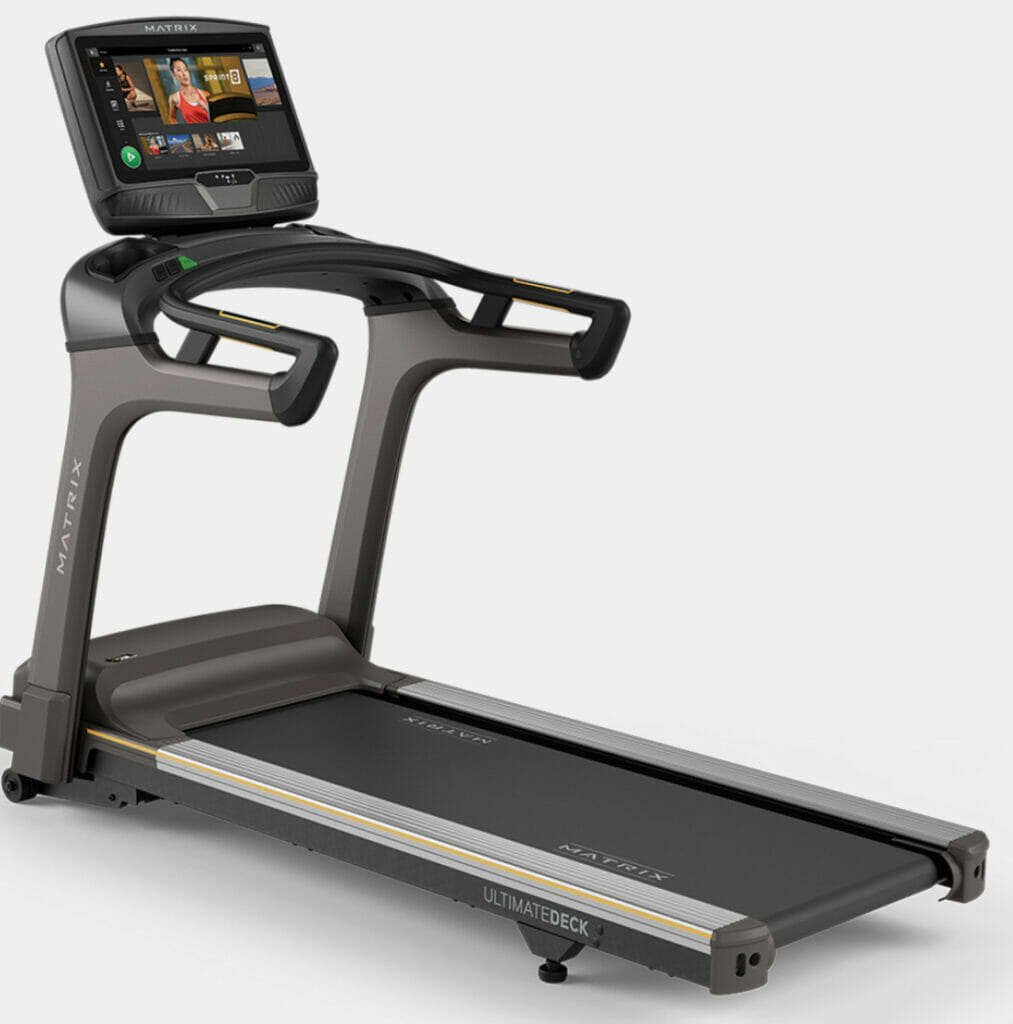
The T75 is a whole lotta treadmill, but if you’re looking for a heavy-duty machine that’s really built to last for the long run, it’s a great choice.
The T75 is Matrix’s premiere treadmill and it has all the impressive specs you’d expect for this price range.
This treadmill comes with a commercial grade, 3.0 HP AC motor that can handle hours of daily use without skipping a beat.
And with a 22″ x 60″ running surface and a 400 lb weight limit, folks of all shapes and sizes will be able to comfortably use it.
And when it comes to the iFit experience, it’s going to be hard to top the 22″ HD touchscreen XUR console (although you can also choose between 3 other more affordable consoles as well).
Not only is the XUR console large and fully equipped with iFit, but it also comes with several other built-in entertainment apps, including Netflix, Hulu, Disney+, and more.
And this console also supports screen mirroring from your phone, so you can really watch anything you want on that gorgeous touchscreen, including other fitness apps.
Matrix also backs this treadmill with a generous warranty: lifetime frame/motor/cushioning, 7 year parts, 2 year labor.
The T75 doesn’t fold and it isn’t cheap, but if you’ve got the space and budget for it, it’s easily one of the best iFit treadmills around.
#2 NordicTrack Commercial 2450
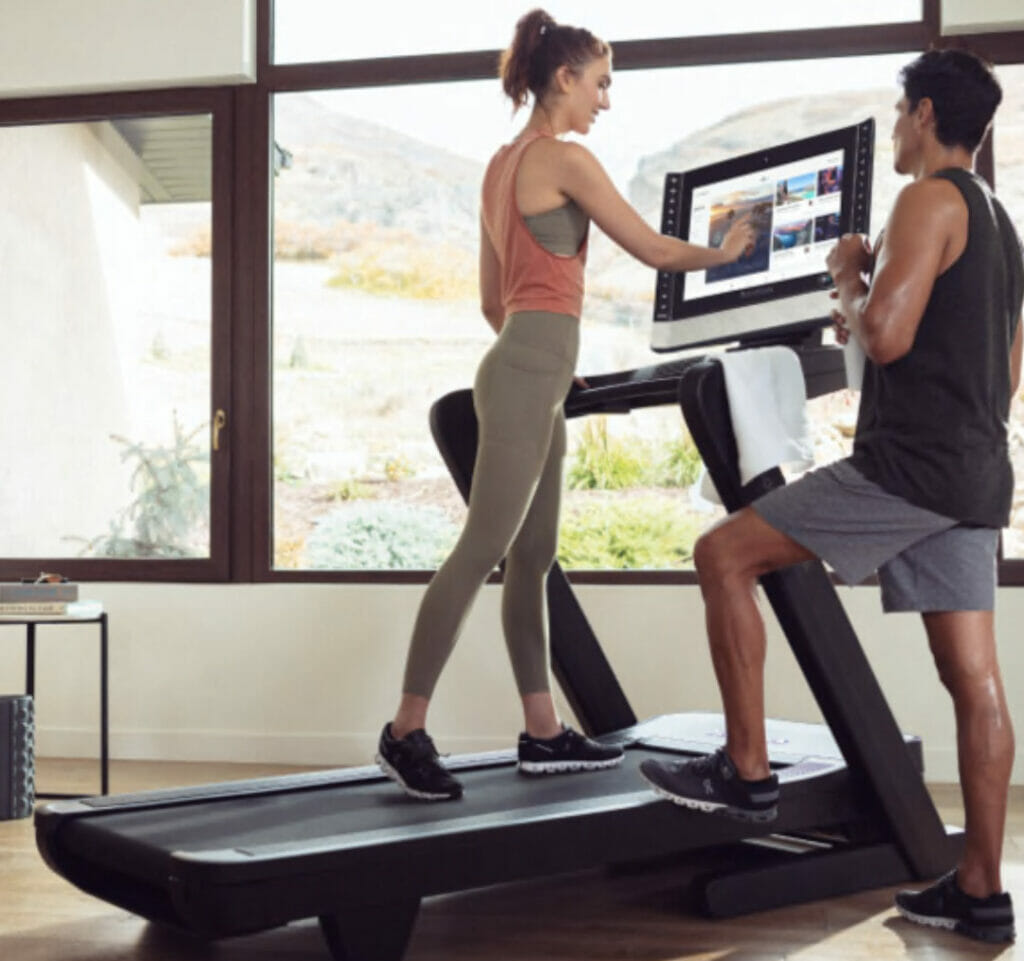
The Commercial 2450 is a nice all-around home treadmill and even though it isn’t nearly as heavy-duty as the T75, it isn’t nearly as expensive either.
The warranty is quite a bit shorter too, but it’s still got some great features to offer.
Under the hood, the Commercial 2450 is packing a 3.6 CHP motor that can reach a top speed of 12 mph and a top incline of 12%.
And if you like the idea of walking downhill, you’ll appreciate that this treadmill can also reach a decline angle of -3%.
It also comes with a respectable 20″ x 60″ running surface and a 300 lb weight limit, which honestly, are both pretty average for this price range.
But what isn’t average, is the 22″ HD, pivoting touchscreen console it comes with.
This large console makes it easy to view your iFit workouts whether you’re on the treadmill or doing an off treadmill workout (iFit offers many).
And with bluetooth headphone and heart rate strap compatibility, it’s got ya covered for when you need to keep the noise level down.
Overall, the Commercial 2450 is one of NordicTrack’s top models and a great choice for folks looking for the full iFit experience. See full review.
#3 ProForm Pro 9000
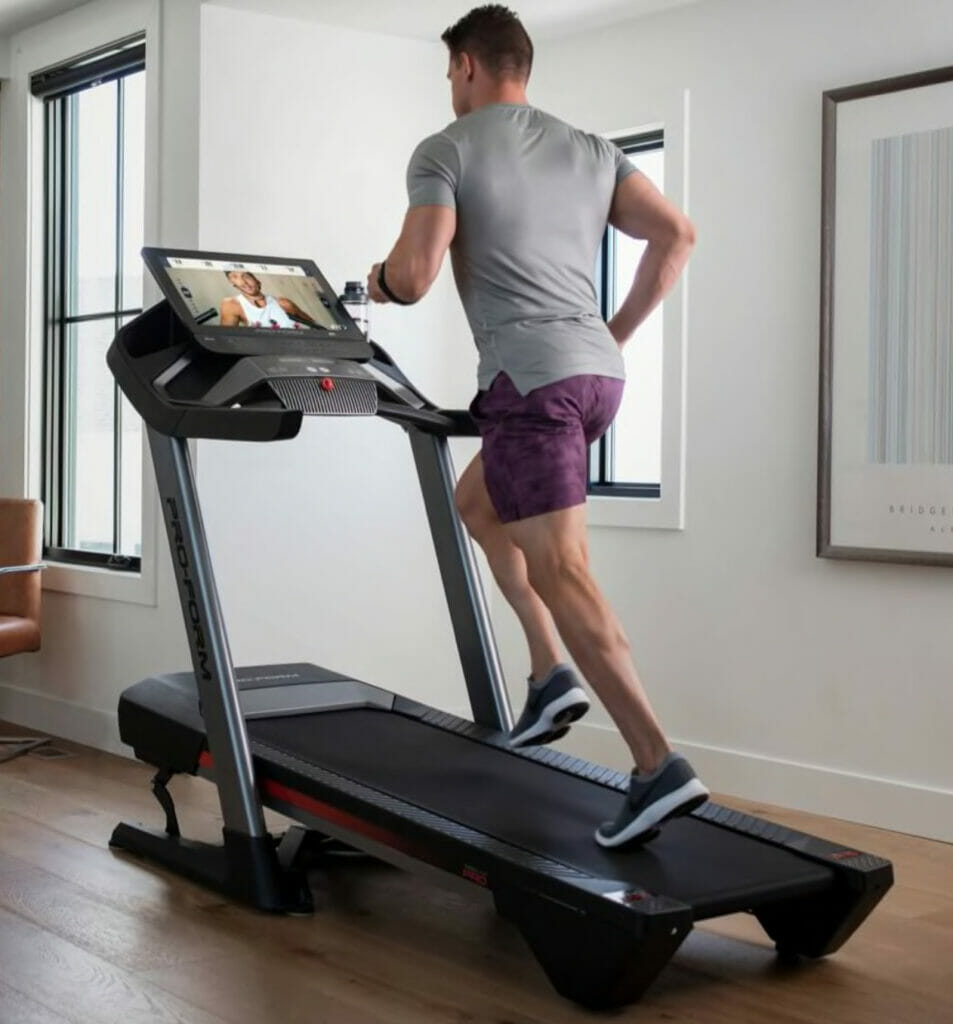
The Pro 9000 is basically a more affordable version of the Commercial 2450 mentioned above.
It isn’t as heavy-duty as the 2450 (which weighs about 40 lb more), but when you check out the rest of the specs, there aren’t many other differences.
The Pro 9000 also comes with a 3.6 CHP motor and a 20″ x 60″ running surface and it too comes with a power incline that can go from -3 – 12%.
The console on this treadmill is also 22″ and HD, but unlike the 2450, it doesn’t tilt and pivot, so it may be a little harder to see when doing off the treadmill workouts.
But with 22″ of screen, it shouldn’t be that hard to see.
ProForm’s warranty for the Pro 9000 is identical to NordicTrack’s (10 year frame, 2 year parts, 1 year labor), so no differences there.
And this treadmill also folds away for storage and is bluetooth compatible with headphones and heart rate straps.
And at the time of writing this, the Pro 9000 costs about $700 less than the 2450, so if you’re looking to save a little cash, it could make a lot of sense. See full review.
#4 Matrix Treadmill TF30
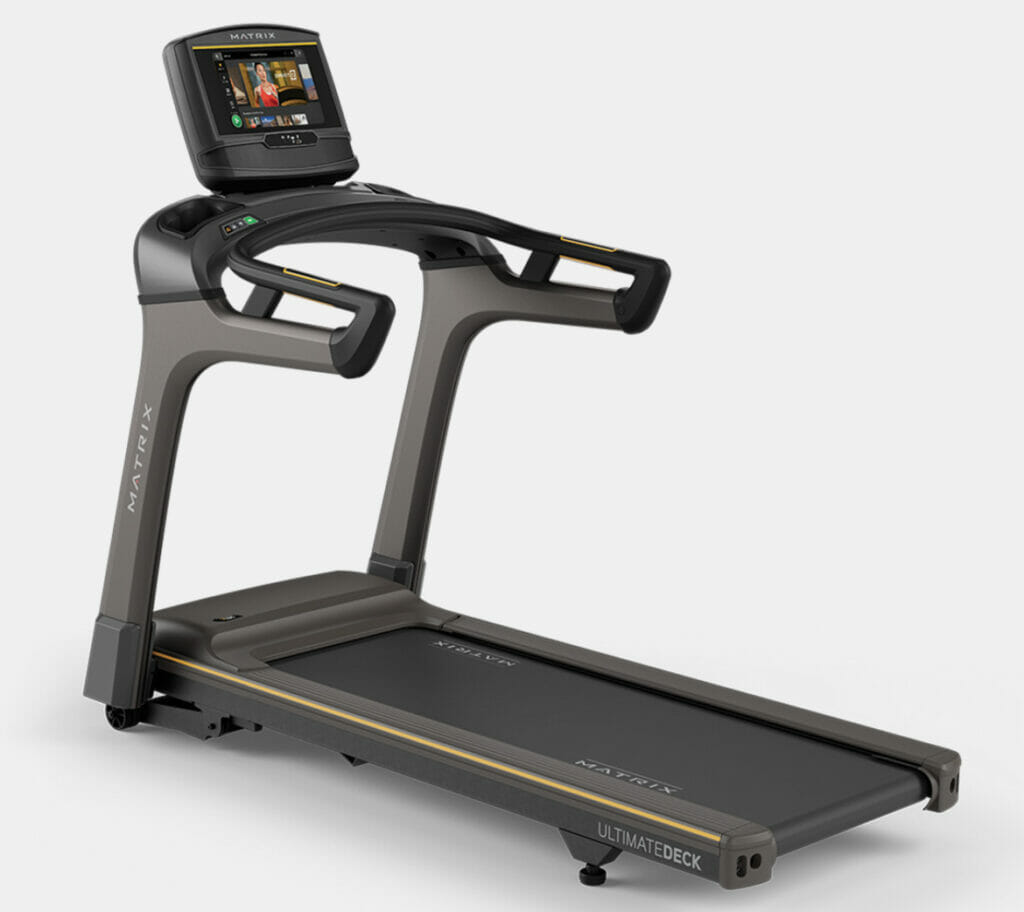
The TF30 is a smaller, folding version of their impressive T75 mentioned earlier and it’s a bit more affordable too.
When it comes to iFit capabilities, with the TF30, you get to choose between 3 different consoles: the 16″ HD XIR, the 10″ HD XER, or the 8.5″ LCD XR.
If you go with the XR, you’ll have to connect the treadmill to your phone to access iFit, but with the XIR and XER you can watch the workouts directly on your console.
These consoles also offer the entertainment apps and screen mirroring options as well.
The TF30 scores highly with its sophisticated consoles, but it’s no slouch in the performance department either.
This treadmill comes with a slightly smaller, 20″ x 55″ running surface, but with a 3.25 HP motor under the hood, it still has enough muscle to power through all your workouts.
I also like that it comes with a heavy-duty frame, a 350 lb weight limit, and a great warranty (lifetime frame/motor/cushioning, 5 year parts, 2 year labor).
Overall, if you’re looking for an elite iFit treadmill that won’t completely destroy your budget, you might want to check out Matrix’s TF30. See full review.
#5 NordicTrack Commercial 1250

The Commercial 1250 is one of NordicTrack’s newer treadmills and it comes with an asking price about $1k less than the 2450 mentioned earlier.
The most obvious difference between these two treadmills is the size of the console – the 1250 comes with a much smaller, 10″ console.
But it’s still an HD touchscreen and it can still tilt and pivot for easier viewing when off the machine.
This treadmill is quite a bit weaker too, coming with only a 3.0 CHP motor, but it can still reach a top speed of 12 mph and has an incline range from -3 – 12%.
The Commercial 1250 also comes with the same 20″ x 60″ running surface, 300 lb weight limit, and warranty NordicTrack offers on all their treadmills.
With the smaller motor, I could see the 1250 being a nice option for folks who aren’t necessarily looking to spend a lot of time running at top speeds.
And of course for folks who are cool with the smaller console (and much smaller price tag). See full review.
#6 FreeMotion t8.9b
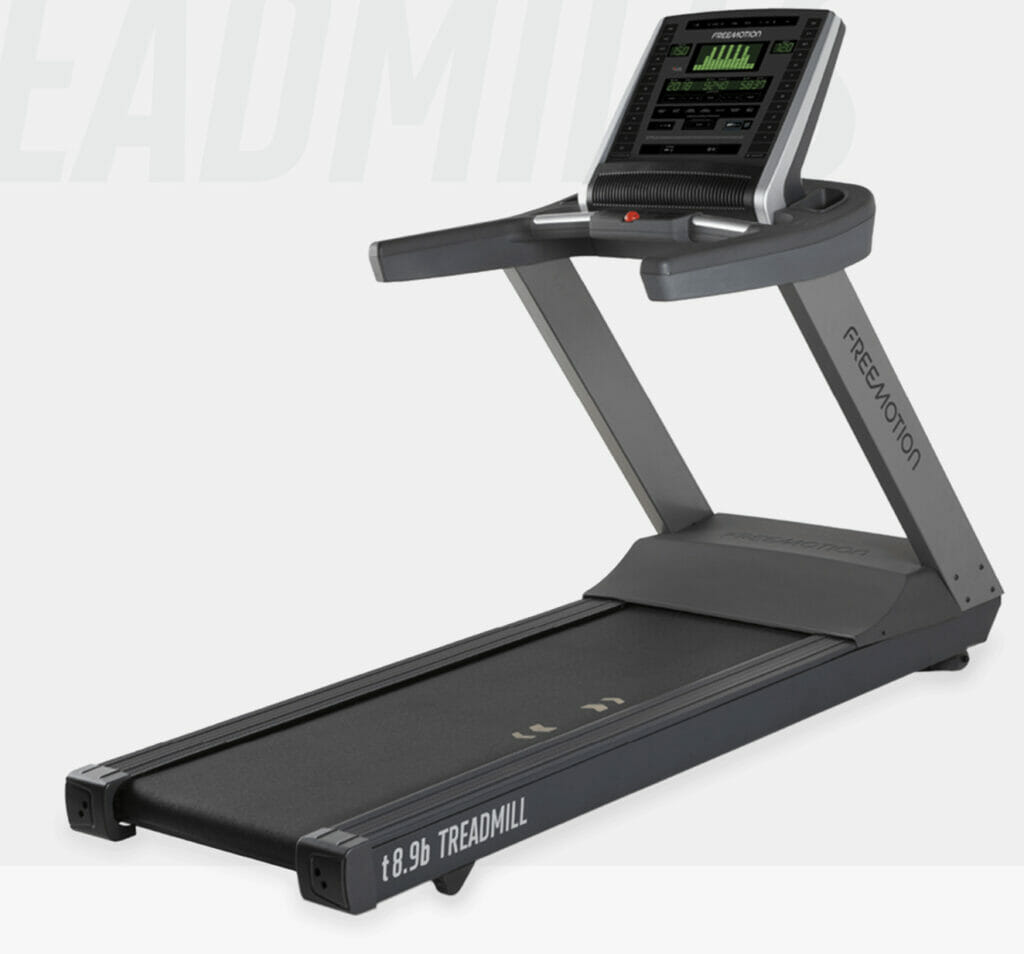
The t8.9b is FreeMotion’s entry-level treadmill and they do offer more impressive machines, but personally, I think their prices are just too high for most home gyms.
But I wanted to include one of their treadmills on this list to show what they have to offer and if you do have the budget for ’em, they really are top of the line models.
Anyway, the t8.9b is their most affordable model to date, but you’d be hard pressed to know that based on its specs.
This treadmill comes with a very powerful, 4.0 HP AC motor that’ll be able to handle anything you can throw at it and a 21.5″ x 60″ running surface for a spacious feel.
The t8.9b also comes with a heavy-duty frame that can handle folks weighing up to 400 lb and huge and 3″ rollers for smooth belt action.
This treadmill doesn’t come with a huge HD console, but its console is compatible with iFit via bluetooth from your phone, allowing you to take advantage of the AutoAdjust technology during workouts.
The console is also really easy to use and comes loaded with several built-in workout programs as well.
So, if you’re looking for a commercial-grade treadmill with iFit capabilities, FreeMotion’s t8.9b is definitely worth considering.
#7 ProForm Pro 2000
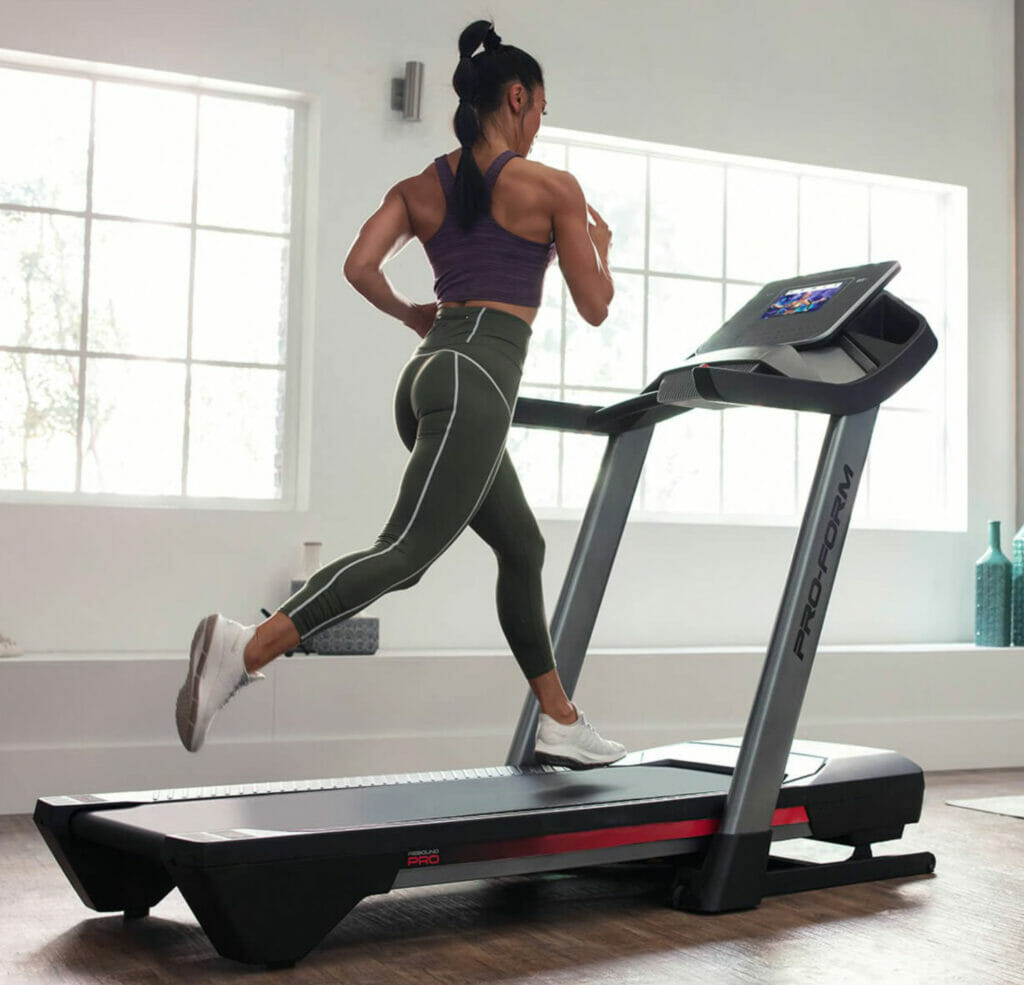
The Pro 2000 is a more affordable version of the Pro 9000 mentioned earlier, so if you like that model but are working with a smaller budget, this one could make a lot of sense.
And it terms of performance, there aren’t a lot of differences between the two.
The Pro 2000 comes with a smaller motor, but at 3.25 CHP, it isn’t that much smaller (and it’s still strong enough to handle runners).
This treadmill also comes with the same 20″ x 60″ running surface, same size rollers (1.9″), and the same warranty.
No, the only other real difference is found in the size of the console – the Pro 2000 comes with a much smaller, 10″ HD touchscreen.
But, if you don’t mind using a smaller screen, you can save some serious cash. At the time of writing this, the Pro 2000 is going for around $1800, making it one of the more affordable iFit treadmills on the market.
And personally, I’d say it has a lot to offer for that price. See full review.
#8 NordicTrack T 6.5 S
Rounding out my list here is an older NordicTrack model that you won’t find being offered directly by NordicTrack anymore, but you can still find it through other retailers like Amazon.
And with an asking price well under $1k, it’s still a hell of a deal.
The T 6.5 S comes with a 20″ x 55″ running surface and a 2.6 CHP motor, so it isn’t the biggest or strongest treadmill around, but for the price, it’s gonna be hard to beat what this treadmill has to offer.
This treadmill comes with a 6.5″ LCD console, so nothing fancy, but it is bluetooth compatible with iFit from your phone, so you can still take advantage of everything iFit has to offer.
And the nice thing about this treadmill is that it comes with 20 or so built-in workouts as well – so if you get tired of paying for iFit, you’ll still have plenty of options to work with.
Other highlights include a top speed of 10 mph, a top incline of 10″, one touch speed/incline buttons, and built-in speakers.
And with a 10 year frame, 2 year parts, and 1 year labor warranty, it’s well protected for a $700 treadmill.
Overall, if you’re looking for an affordable treadmill to get your iFit on, the T 6.5 S is a great choice. See full review.
Buying A Treadmill The Smart Way
Ok, I wanted to include a quick buyer’s guide to go over the top specs and stuff we should be looking for when comparing treadmills because iFit and console features are great, but we want our treadmills to be able to perform as well.
When comparing home treadmills, I encourage you to consider the following:
Running Surface
This spec tells us how much room we’ll have while using the treadmill and it’s one of the most important things to look at when considering a purchase.
Basically, if the running surface is too small for ya, you’re gonna feel cramped while using your treadmill – especially while running.
This spec is usually measured in inches and written as “width x length”.
Most nicer treadmills come with a running surface somewhere in the 20″ x 60″ range because at this size, folks of pretty much any height can comfortably use it without running out of space.
All of the treadmills on this list come with generous running surfaces, so none of these particular treadmills should be an issue.
Motor/Rollers
It’s always a good idea to consider the motor that a prospective treadmill is coming with.
Generally speaking, stronger motors are able to get the job done without working as hard, so they tend to provide a smoother experience.
And since they don’t have to work as hard as weaker motors, they should technically last longer too.
Most home treadmills come with motors somewhere in the 2 – 4 HP range, although there are cheaper treadmills out there with weaker motors.
If you plan on running regularly, it’s smart to go with a treadmill with at least a 3 HP motor to make sure it can keep up.
Rollers are the parts at the front and rear of the treadmill that actually make contact with the belt, allowing it to glide over the deck.
Treadmill rollers come in various sizes, with most falling somewhere between 1.9″ – 3″.
Having larger rollers is a good thing because it makes for an overall heavier-duty treadmill, but it also makes for smoother belt action.
Higher-end, more expensive treadmills should come with larger rollers, while more affordable treadmills usually come with smaller rollers.
Frame
Most treadmills more or less come with the same footprint, give or take a few inches, so when checking out the frame, I’m really looking for the weight limit and the assembled weights.
You’ll also want to consider whether or not the frame folds.
But it’s the weights I’m most concerned with because these numbers give you a good idea as to how sturdy or robust you can expect the treadmill to feel.
And seeing higher numbers in both of these categories is always a good thing.
Heavier treadmills are harder to move, sure, but this also means they’re gonna be less likely to wiggle or wobble during use.
And seeing a higher weight limit is just another indicator of better overall build quality.
Heavier-duty treadmills will come with assembled weights in the 300 – 400 lb range, but anything over 200 lb is pretty decent.
When it comes to weight capacities, I like to see at least a 300 lb limit.
Warranty
The warranty is always one of the first things I look at when scoping out a new treadmill because this is your insurance policy – if something goes wrong, it’s nice to know you’re covered.
Treadmills usually come with warranties that are broken down into a few components:
- Frame
- Motor
- Deck
- Parts
- Labor
The most generous warranties will offer lifetime coverage for the frame, motor, and even the deck.
Many brands offer 2-3 years on parts, but you’ll see 5-10 year part guarantees on some treadmills and this is a good sign of build quality.
After all, it’s unlikely the frame is gonna break down on ya – more times than not, if something goes wrong, it has to do with something covered under ‘parts’.
Most brands only offer a year on labor, but as you saw above, some brands go above and beyond and offer 2 year labor warranties.
By the way, the labor warranty covers the cost of having to pay someone to come out and fix your treadmill.
When in doubt, I say go with the treadmill with the better warranty.
Final Thoughts
Ok, I think that’ll do it.
When you combine all 4 compatible brands, there are actually a lot of iFit ready treadmills out there.
Going with a treadmill that already has a built-in HD touchscreen is convenient, just know you’ll have to pay more for it.
If you want to save some cash, you can go with a treadmill that has a simpler console and use your phone or tablet to connect with iFit.
Both options will let you use the AutoAdjust feature that lets the instructors automatically control your treadmill settings.
Otherwise, I encourage you to look at those key performance specs (running surface, motor, warranties) and find a treadmill that fits your needs and budget.
I hope you found this guide helpful and if you know of any treadmills that deserve a spot on this list, leave a comment below and I’ll get back to you shortly.







